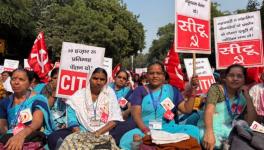Scheduled Castes in the Indian Labour Market

Image courtesy Oxford University Press, 2023
In Scheduled Castes in the Indian Labour Market: Employment, Discrimination and its Impact on Poverty (Oxford University Press, 2023), Sukhdeo Thorat, S Madheswaran and BP Vani delve into the economic theories surrounding caste discrimination and the resulting inter-caste disparities in employment, unemployment, wages and occupation.
The book examines the impact that employment and wage discrimination have on the income and poverty levels of scheduled caste workers. It suggests affirmative action policies as a solution to overcome employment and wage discrimination.
The following is an excerpt from the book.
11.2 Caste Inequality in Wage Income and Poverty
11.2.1 Wage Income and Poverty
It emerged that the wage earning of the SC regular salaried workers is lower than the higher castes workers. This affects the consumption expenditure of the SC regular salaried workers. The consumption expenditure of the SC is ₹1,674 which is lower than ₹1,952 for the Other Backward Classes (OBC) and ₹2,712 for the higher castes, while the all-India average is ₹2,017. The consumption expenditure of the SC is 61 per cent of the higher castes and 85 per cent of the OBC.
The caste disparities in per capita consumption expenditure also result in gap in poverty of these three castes. In 2011–12 (the latest year for which the poverty data is available), the incidence of poverty among the SC is significantly higher than the higher castes and OBC. At the national level, about 17 per cent of the regular salaried workers are poor. But the incidence of poverty among the SC regular salaried workers is about 23 per cent which is higher than the all-India average and higher castes (10 per cent) and OBC (18 per cent). Thus, there is graded inequality both in per capita consumption expenditure and poverty. The per capita consumption expenditure is highest for the higher castes and considerably reduces as we go lower in the caste hierarchy. The opposite is the case for poverty—it increases as we move down in the caste hierarchy from higher castes to middle castes, the OBC, and to the SC.
11.2.2 Inequality in Employment and Wages
The labour market outcomes in terms of employment, wages, and occupations are unequal between the SC and the higher castes. In case of occupations, it emerged that a high percentage of SC workers are employed in low-paid elementary and unskilled occupations. A relatively high proportion of the SC workers are engaged in agriculture and construction industry. Thus, although there has been a break from the restrictions occupations, the traditional occupational segregation or concentration of the SC in low-paid work continues in the present.
Coming to employment, the probability of employment is low for the SC as compared to the higher castes. The gross difference in probabilities of getting employment between the SC and the higher castes is 0.088 in 2004–05 and 0.070 in 2017–18, indicating a lower probability of employment for the SC as compared to the higher castes. Low probability of employment results in a high unemployment rate among the SC. In 2017–18, the unemployment (based on current weekly status) rate was 10.5 per cent for the SC which is higher than 8.3 per cent for the higher castes and 8.1 per cent for the OBC. The inter-caste differences are greater in urban areas (11.1 per cent for the SC, 8.7 for the higher castes and 9.5 per cent for the OBC). In rural areas too, the rates are 10.4 per cent for the SC, 8 per cent for the higher castes and 7.6 per cent for the OBC. Thus, without exception, the SC suffers more from unemployment than the higher castes.
Unemployment is generally high at all levels of education among the SC. However, the gap between the SC and the higher castes is particularly high for levels beyond higher secondary and graduate. Among the SC, the youth in the age group of 15–29 years suffered the most from unemployment as compared to their higher caste counterparts.
On the basis of the category of employment, the SCs are concentrated in agriculture and construction industry. Their share in the construction industry is almost three times higher than that of the higher castes. The reverse is the case in manufacturing, trade, storage, restaurant, and other services. Thus, the shares of the SC in low-paid ‘agriculture and related activities’, and ‘construction’ are much higher as compared to the higher castes. Higher engagement of the SC in low-paying economic activities is also visible in their higher employment in some occupations. Clearly, the share of SC in three occupations, namely, legislators, senior officials and managers, professionals and clerks, is low; but it is high in low-paying jobs, such as elementary or unskilled occupations, domestic helpers, cleaners, garbage collectors, etc. It, thus, appears that the SC presumably continues to face restrictions in occupations which were prohibited to them in the past.
The wage earning of the SC regular salaried workers is found to be lower than that of the higher castes by almost 30 per cent. The wages of the SC are found to be lower in almost all occupations. Wage earning also varies between the public and the private sectors. The wage gap between the SC and the higher castes is more in the private sector as compared to the public sector. This is particularly the case in the urban private sector. While this is the pattern at the aggregate level, the wage gap between the SC and the higher castes varies across the wage distribution, i.e. between the lower and upper quintiles. In the public sector, the wage gap between the SC and the higher castes is higher at the bottom percentiles, i.e. below 50th percentile, than at the upper percentiles of the wage distribution. On the other hand, in the private sector, the wage gap between the SC and the higher castes are higher at the upper percentiles, i.e. above 50th per-centile, than at the bottom percentiles of the wage distribution. Thus, the caste inequalities between the SC and the higher castes in employment/ unemployment, occupations, and wages continue to persist despite the guarantee of equal opportunity in the Constitution.
11.3 Caste Discrimination: Employment, Wages,
and Occupations
The study also explored the sources of inequality between the SC and the higher castes in employment/ unemployment and wages, as attributable to differences in endowment factors and discrimination in employment, wages, and occupations.
11.3.1 Employment Discrimination
The gross difference in probabilities of securing employment between the SC and the higher castes was 0.088 in 2004– 05 and 0.070 in 2017– 18 indicating a lower probability, albeit with a narrow gap, for the SC as compared to the higher castes. The gap in the probability of getting employment among the SC and the higher castes was partly due to differences in endowment factors (such as ownership of capital assets and higher education) and partly due to discrimination in employment. The decomposition of gross difference in probability of access to employment between the SC and the higher castes shows that discrimination accounted for about 74 per cent of the differences in employment in 2004– 05 and 73 per cent in 2017– 18 and the remaining 26– 27 per cent was due to differences in endowment factors. Thus, the low probability of employment for the SC as compared to the higher castes is mainly caused by caste discrimination in hiring.
The Intensity of discrimination is greater in the private sector as compared to the public sector. In the private sector, employment discrimination accounted for about 53.15 per cent of the differences in the probability of access to employment which is much higher as compared to 14 per cent in the public sector. Conversely, the results on unemployment confirmed these findings. Discrimination accounts for about 65 per cent differences in the unemployment rate between the SC and the higher castes and endowment factors account for about 35 per cent. Thus, in employment the discrimination matters more than the endowment factors in causing high degree of unemployment among the SC.
11.3.2 Wage Discrimination
In case of wage discrimination, however, the endowment factors had a relatively greater impact than discrimination in explaining the wage gap between the SC and the higher castes. About 57 per cent of the wage gap between the SC and the higher castes was due to the endowment differences, with the rest being attributable to caste discrimination. Among the endowment factors, the differences in education, particularly higher education, between the SC and the higher castes contribute greatly to the earning gap between these two groups. The wage gap between the SC and the higher castes due to education and skill was 67.1 per cent in 2004– 05 and 57.24 per cent during 2017– 18. The higher castes have an edge in higher education (graduate and above) as compared to the SC. The other factors include marital status and nature of employment. Women’s education also matter. Conversely, low access to education, including access to education of SC women, and quality of employment remain a disadvantage for the SC workers. This implies that the exclusion of the SC from access to education, employment (other than casual wage labour), and capital assets for a long time in the past seems to continue in the present as a legacy of the caste system in new forms. The discrimination in the ‘present’ remains an important factor in the wage gap between the SC and the higher castes.
The results of the decomposition of the discrimination component into overpayment to the higher castes and underpayment to the SC in the labour market imply the advantage of discrimination to the higher castes and the disadvantage to the SC. The results revealed that overpayment or treatment advantage to the higher castes (benefit of being higher castes in the labour market) was 8.6 per cent in 2004– 05 and 16.46 per cent in 2017– 18. This reflects the difference in the current wages of the higher castes which they would receive in the absence of discrimination. It also reflects nepotism towards the higher castes. On the other hand, the underpayment or treatment disadvantage to the SC (cost of being SC in the labour market) was 24.3 per cent in 2004– 05 and 26.30 per cent in 2017– 18. This measure depicts the difference in the current wage of the SC and the wage which they would receive in the absence of discrimination. This shows the ‘cost’ to the discriminated group against the ‘benefits’ accruing to the advantaged group. Overall, we find that the cost of being SC in the labour market is very high. They are hugely underpaid in the labour market.
The results also revealed differences in wage discrimination in the public and private sectors. The caste- based wage gap is higher in the private sector than in the public sector. Irrespective of the wage quintiles, the wage gap attributable to discrimination is high in the private sector than in the public sector. Within the private sector, however, the wage gap at high percentile level (i.e. 90th percentile) is higher than the estimated wage gaps in other parts of the wage distribution. This gives evidence of the ‘glass ceiling effect’ in the private sector which means that the SC employees face caste- related constraints in moving to higher positions. They seem to face a ‘ceiling’ in the upper mobility in the hierarchy of jobs in the private sector, despite qualification similar to the higher castes employees.
In the public sector, the wage discrimination is lower than in the private sector (except at the lower levels of wage distribution). Indeed, wage gap and level of discrimination in the public sector is consistently below the private sector across the entire range of wage distribution. However, unlike private sector, the wage gap attributable to discrimination decreases in the public sector as we move up along the wage distribution. This means that discrimination is high at a lower level of wage distribution than at the upper level. The opposite is true for the private sector. The wage gap attributable to discrimination is lower at the lower end of wage earning than at the upper end of wage earning. Thus, irrespective of the methodology used, the empirical evidence clearly exhibits high degree of discrimination against the SC in the private sector, particularly in positions with higher levels of earnings.
11.4 Occupation Segregation
The results show that in the regular salaried labour market, occupation discrimination accounts for a substantial part of the gross earnings differential between the SC and the higher castes, with occupational discrimination (inequality in access to certain occupations) being highly pronounced than wage discrimination (unequal pay within a given occupation, given one’s educational and skill levels). Within the SC the younger cohorts faced higher degree of discrimination in allocation of type of jobs or work than the older cohorts.
11.5 Impact of Discrimination
on Untouchables’ Poverty
The findings related to combine impact of employment and wage discrimination (including occupation discrimination) on the poverty of the SC regular salaried workers are quite telling, insofar as they disclose the sources of persistently high poverty among the SC when compared to similarly placed workers from the higher castes. By estimating the impact of labour market discrimination on the income and poverty of the SC regular salaried workers in numerical terms, it approximates the magnitude of the income loss of the SC regular salaried workers and its contribution in pushing such workers into poverty. This also discloses the reasons as to why the SCs are caught in a chronic poverty trap.
We saw that after accounting for the wage loss and employment loss due to discrimination in their total consumption expenditure, the incidence of poverty declined by 7.1 percentage points during 2004– 05 and 9.2 percentage points during 2017– 18 for the SC. These imply that nearly 0.79 million SC regular salaried wage workers would be out of poverty in the absence of caste discrimination during 2004– 05. During 2017– 18, 1.6 million SC regular salaried wage workers would have been out of poverty in the absence of caste discrimination. These are extremely profound results as these provide creditable empirical evidence on the poverty enhancing effects of discrimination of the SC in employment, wages, and occupations in labour market— a link between unequal outcome of labour market due to discrimination and chronic poverty of the SC in India is indeed real.
This is an excerpt from Scheduled Castes in the Indian Labour Market: Employment, Discrimination and its Impact on Poverty, published by Oxford University Press, 2023. Republished here with permission from the publisher.
Sukhadeo Thorat is Emeritus Professor, Jawaharlal Nehru University, New Delhi; K.R. Narayanan Chair for Human Rights and Social Justice, Mahatma Gandhi University, Kerala; Chairman, Indian Institute of Dalit Studies, New Delhi; and Chairman, Institute for Social and Economic Change, Bangalore.
S. Madheswaran is Professor, Centre for Economic Studies and Policy, Institute for Social and Economic Change, Bangalore.
B.P. Vani is Associate Professor, Centre for Economic Studies and Policy, Institute for Social and Economic Change, Bangalore.
Get the latest reports & analysis with people's perspective on Protests, movements & deep analytical videos, discussions of the current affairs in your Telegram app. Subscribe to NewsClick's Telegram channel & get Real-Time updates on stories, as they get published on our website.
























